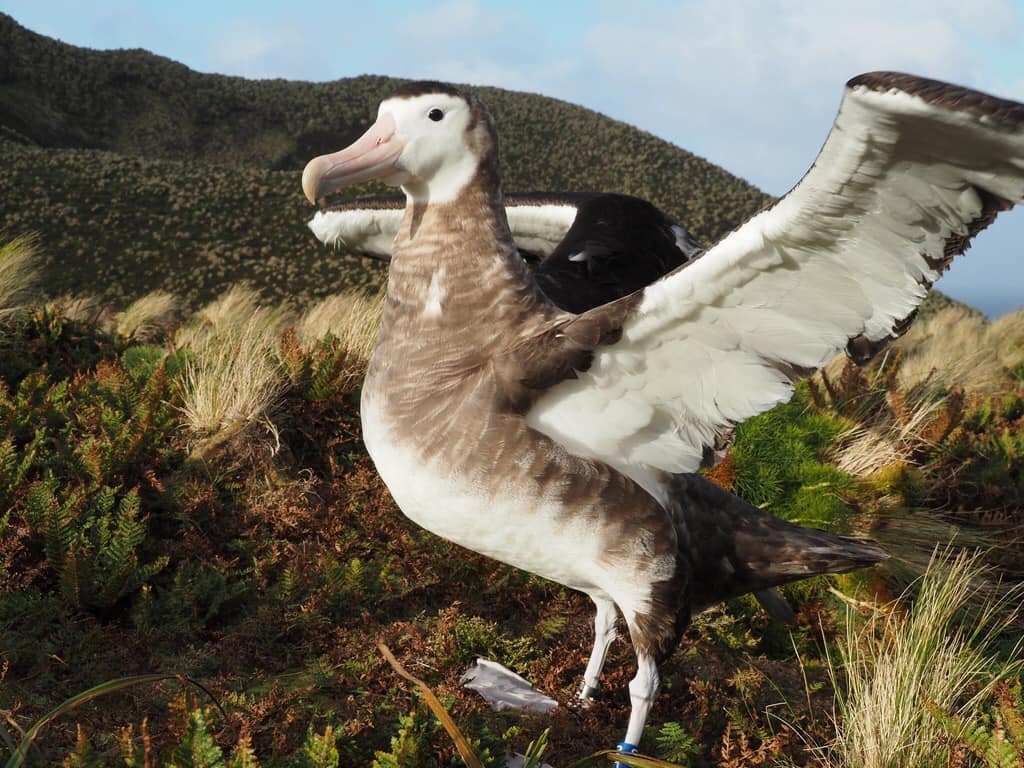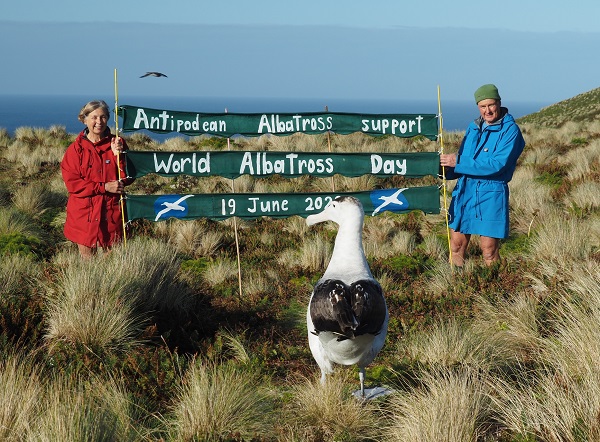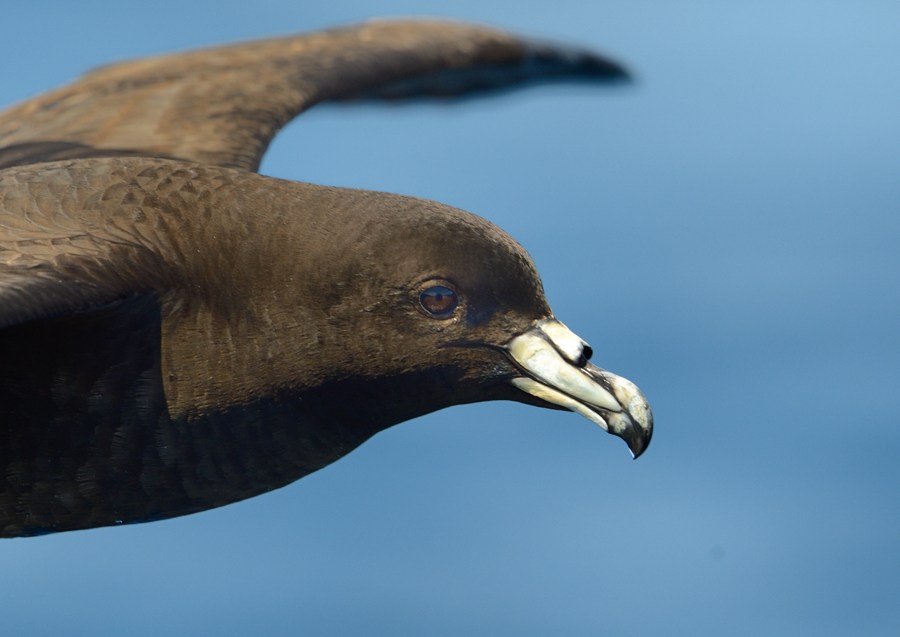
Southern Royal Albatrosses display on Campbell Island
The Conservation Service Programme of New Zealand’s Department of Conservation has published four final reports for project BCBC2019-03: Seabird population research, Campbell Island 2019/20 that cover population monitoring and surveys conducted on albatrosses and petrels on the island during the austral summer.
The following text summarizing the four reports comes from the Department of Conservation:
Field survey component
The objectives of this project were to collect photo-point and ground-truthing data at Campbell and grey-headed albatross colonies, repeat whole-island counts of breeding Northern giant petrels, collect GLS trackers from Southern royal albatrosses, use sound recorders to record burrowing petrel distribution and check the bands of all banded birds seen. The 1996 census of breeding Northern giant petrels (Macronectes hallii) around the island was repeated. Adjusting chick counts to correct for breeding failures gave an estimated 150 (range 134–173) breeding pairs in 2019. This appears broadly similar to the last count in 1996. Three tracking devices were recovered from Southern royal albatrosses (Diomedea epomophora). Numbers of Southern royals in the Col-Lyall colony seemed low, highlighting the need to repeat the island-wide census last done 2004–08, and to resume mark-recapture in the study colony to assess the population’s current status. Sound recorders captured white-headed petrels (Pterodroma lessonii) calls at Campbell Island, supporting the idea that a small population may breed there. Recorders also provided evidence that white-chinned petrels (Procellaria aequinoctialis) are recolonising multiple areas on the main Campbell Island from its offshore islets, extending the known distribution northward to Northwest Bay and Switchback Ridge.
Photo count component
Aerial photographs were taken during two Navy helicopter flights along the coast, six days apart in mid-to-late November 2019. Ground-level photographs were taken from 14 fixed vantage points overlooking the eight sites where mollymawks breed. Information on overall numbers were derived for the larger colonies from the aerial photographs, supplemented by more detailed information on species composition and what proportion of the birds were sitting on nests or standing (occasionally sitting) around, either as partners of nesting birds, or as courting pre-breeders, or simply just loafing.
Overall, an estimated 22,766 Campbell Mollymawks and 5,937 Grey-headed Mollymawks appeared to be occupying nests, although not all of these necessarily involved a bird sitting on an egg. In a contemporaneous survey at the Bull Rock South colony, 18% of occupied nests were empty. If this figure applies more widely, the actual number of breeding pairs at the time of the survey could be lower: 18,668 and 4,868 pairs of Campbell and Grey-headed mollymawks, respectively. A further 4,933 Campbell Mollymawk individuals (just under 18 % of the species’ total) and 1,344 Grey-headed Mollymawks (just over 18 % of that species’ total) were recorded loafing. The November 2019 survey was carried out about three-fifths of the way through the species’ incubation period, assuming peak egg laying around 10th October. By the time of the survey, some nests would have failed, so the initial number of nests will be higher. Using regression formulae developed during earlier surveys to account for these losses, the number of nesting Campbell and Grey-headed Mollymawk pairs at the start of the 2019 breeding season was estimated to be 24,338 and 6,429, respectively.
These figures, compared with those covering the past 25 years, suggest that the Campbell Mollymawk population is relatively stable, whereas the Grey-headed Mollymawk population has continued to decline by around 0.84 % per annum since the mid-1990s.
Southern Royal Albatross breeding assessment
A March 2020 trip to Campbell Island included follow-up work from the November 2019 trip in addition to work focusing on southern royal albatross (Diomedea epomophora). The main aims were retrieving GLS devices, resighting bands and PIT tags, and conducting nest counts of southern royal albatross in the Col study area (and Honey index area, if time permitted). Nest counts would be used to gain insight into population trends and provide a ground count to compare to aerial photographs and satellite imagery. Aerial photographs of the Campbell (Thalassarche impavida) and grey-headed albatross (T. chrysostoma) colonies at Bull Rock and adjacent north-eastern colonies were repeated from November to determine breeding success. Sound recorders were deployed on Beeman Hill to assess abundance and distribution of petrels.
Mollymawk chick numbers and survival
An aerial photographic survey of the mixed Campbell Mollymawk, T. impavida, and Grey-headed Mollymawk, T. chrysostoma, colonies along the north-east coast of Campbell Island was carried out on 17 March 2020. At this time, most of the birds present at these colonies would have been chicks. The aim of the study was therefore to establish the number of chicks in these colonies and relate this to the number of nesting adults estimated from a combined aerial and ground level photographic survey carried out earlier in the nesting season in November 2019. Campbell Mollymawks made up 90 % of these nesting birds, with Grey-headed Mollymawks the remainder. Overall nesting success at the mixed mollymawk colonies along the north-east coast of Campbell Island during the 2019–20 breeding season was 50–60 %, with a best estimate of around 58 %. This is broadly in line with the level of nesting success measured for Campbell Mollymawk during 1984–96, the predominant species present in these colonies.

A Grey-headed and a Campbell Albatross interact on Campbell Island, photographs by Rachael Orben
References:
Frost, P.G.H. 2020. Status of Campbell Island and Grey-headed Mollymawks on the northern coasts of Campbell Island, 2019. Whanganui: Science Support Service. 25 pp.
Frost, P. & Mischler, C. 2020. Mollymawk Chick Numbers and Survival on Campbell Island, November 2019-March 2020. Whanganui: Science Support Service & Twizel: Department of Conservation. 14 pp.
Mischler, C. 2020. Campbell Island/ Motu Ihupuku Seabird Research March 2020. Twizel: Department of Conservation. 25 pp.
Rexer-Huber K., Parker K.A. & Parker G.C. 2020. Campbell Island Seabirds: Operation Endurance November 2019. Final Report to Department of Conservation, Marine Species. April 2020. Dunedin: Parker Conservation. 23 pp.
Reports available here.

 English
English  Français
Français  Español
Español 



